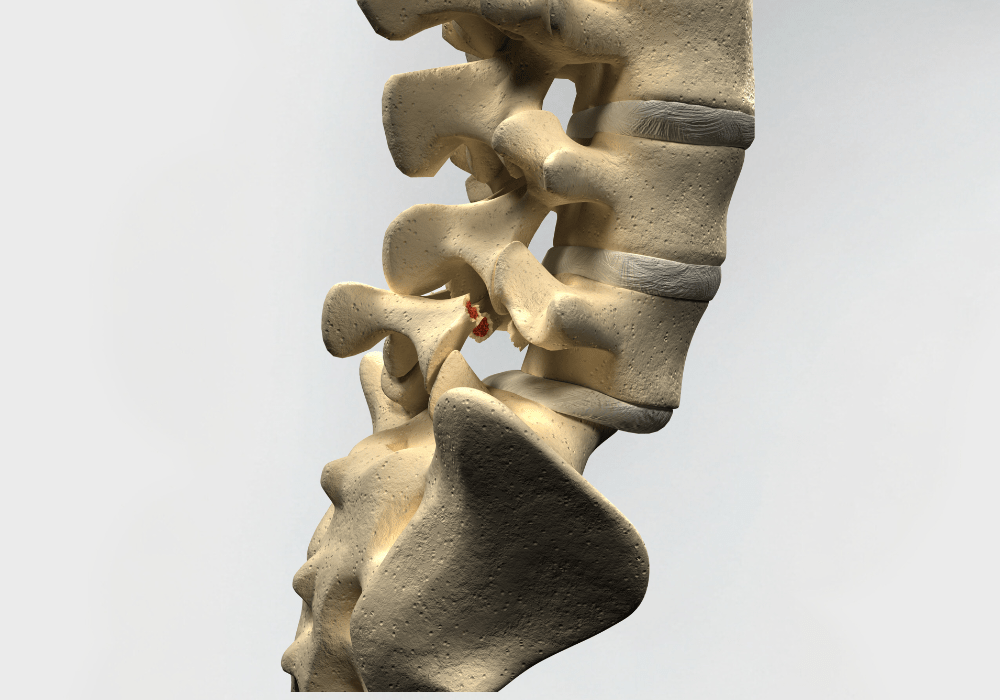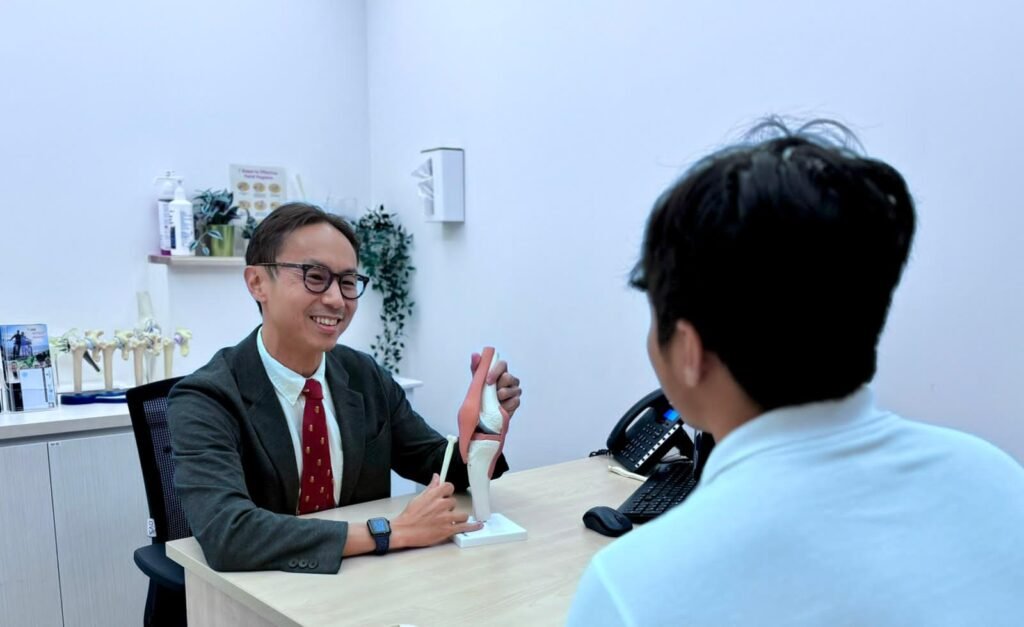Spondylolisthesis treatment in singapore, a spinal disorder characterized by the forward slipping of one vertebra over the vertebra below it, is most commonly detected in the lumbar spine, located in the lower back. This condition manifests in various forms, each with distinct origins and characteristics. Congenital spondylolisthesis, present from birth, arises from abnormal bone development. On the other hand, degenerative spondylolisthesis primarily affects older individuals due to age-related wear and tear on the spine. Isthmic spondylolisthesis results from flaws or fractures in the pars interarticularis, a specific region of the vertebra. Pathological spondylolisthesis is induced by underlying disorders weakening the spine, while traumatic spondylolisthesis stems from acute injuries or trauma to the spine. Understanding these distinctions is vital for accurate diagnosis and effective treatment strategies tailored to each patient’s unique condition.

Spondylolisthesis, a spinal disorder characterized by the forward slipping of one vertebra over the vertebra below it, is most commonly detected in the lumbar spine, located in the lower back.
Spondylolisthesis occurs when one vertebra slips over another due to various underlying factors. Degenerative spondylolisthesis is often attributed to aging, which leads to the deterioration of spinal tissues, particularly the intervertebral discs. Congenital spondylolisthesis results from defects in spinal development during fetal stages, making the spine weaker and more susceptible to slippage. Isthmic spondylolisthesis, linked to abnormalities or fractures in the pars interarticularis, is often associated with trauma or repetitive stress, especially in sports like weightlifting or gymnastics.
Traumatic spondylolisthesis is caused by sudden, severe spine injuries, such as falls or accidents, leading to instability and vertebral displacement. Pathological spondylolisthesis is related to underlying diseases like osteoporosis, malignancies, or infections that compromise spinal integrity and promote slippage. Identifying the specific cause of spondylolisthesis is crucial for creating personalized treatment plans and preventing further complications.



Back Pain in the Lower Back:
Lower back pain, usually centered around the afflicted vertebra.
Certain actions, like standing, walking, or bending forward, can make pain worse.
Lying down or getting some rest may help with pain.
Decreased Flexibility and Stiffness:
Lower back pain when bending or twisting.
Lower back pain or stiffness, especially after extended periods of inactivity.
Muscle Tightness or Spasms:
Lower back muscles, particularly those around the injured vertebra, may feel tight or tense.
Radiating Pain and Numbness (Sciatica):
Pain, tingling, or numbness that travels down one or both of the legs from the lower back.
Weakness:
Weakness in one or both legs, especially in the muscles that are derived from the injured spinal nerve. weakness can impair stability and movement, making it challenging to stand or walk.
Changes in Posture:
Modifications in posture, including a waddling walk or a forward-leaning stance.
Postural changes could be brought on by spondylolisthesis-related discomfort or weakening in the muscles.
Difficulty Performing Daily Activities:
Pain, stiffness, weakness, or restricted mobility that makes it difficult to perform daily activities. It may be impacted whether walking, standing, sitting, or lifting.
A disorder known as spondylolisthesis occurs when one vertebra slips forward over the lower one. The degree of slippage and the severity of symptoms determine the available treatment choices. The following are a few typical therapies:
When conservative therapies fail to reduce the symptoms or when the condition is severe, surgery becomes a viable option for treating spinal issues. There are several surgical alternatives available, each targeting specific aspects of the condition to provide relief and restore function.
Spinal Fusion
Spinal fusion is a stabilizing procedure designed to address spinal instability or deformity. During the procedure, the surgeon joins two or more vertebrae together using bone grafts, which may be sourced from the patient’s own body or a donor, along with metal hardware such as rods, screws, or plates. Over time, the bone grafts fuse with the existing vertebrae, creating a solid mass of bone that stabilizes the spine and reduces pain. Spinal fusion is commonly used to treat conditions such as spinal stenosis, spondylolisthesis, or degenerative disc disease.
Laminectomy
Laminectomy is a surgical procedure aimed at relieving pressure on the spinal cord or nerves by removing a portion of the lamina, the rear part of the vertebra. This procedure is often recommended for conditions such as spinal stenosis, where the spinal canal becomes narrowed and compresses the spinal cord or nerve roots. By removing part of the lamina, the surgeon creates more space within the spinal canal, alleviating pressure and reducing symptoms such as pain, numbness, or weakness. In some cases, a laminotomy, which involves removing only a portion of the lamina, may be performed as a less invasive alternative to laminectomy.
Decompression
Decompression surgery aims to relieve pressure on the spinal nerves by removing tissue that is pressing on them. This tissue may include herniated disc material, bone spurs, or thickened ligaments. Decompression procedures vary depending on the specific condition and location of the compression. For example, a discectomy involves removing a portion of a herniated disc that is pressing on a nerve, while a foraminotomy enlarges the openings in the vertebrae through which the spinal nerves exit. Decompression surgery can provide significant relief from pain and other symptoms associated with nerve compression.
Each surgical option has its own benefits, risks, and considerations, and the choice of procedure depends on factors such as the underlying condition, the extent of spinal damage, and the patient’s overall health and lifestyle.
The goals of post-surgical care for spondylolisthesis are to decrease discomfort, accelerate healing, and return function.
Pain Management:
To control discomfort during the early stages of recovery, doctors frequently prescribe pain medication. For severe pain, these could be opioids; for milder pain, nonsteroidal anti-inflammatory medications (NSAIDs) or acetaminophen.
Activity Limitations:
After surgery, patients are typically recommended to refrain from heavy lifting and strenuous activities for a set amount of time. Under a healthcare provider’s supervision, gradual increases in activity levels are advised.
Exercise:
One of the most important aspects of post-operative recovery is exercise. Exercise recommendations from a therapist will increase the spine’s and the surrounding muscles’ strength, flexibility, and mobility. Inpatient and outpatient therapy are two possible starting points for therapy.
Wound Management:
To stop infection and encourage healing, wound management is crucial. Patients are taught proper hygiene practices, such as keeping the incision sites dry and clean.
Follow-up sessions: Patients will see their surgeon for follow-up sessions to track the status of their recovery, evaluate their degree of discomfort, and discuss any issues or problems.
Gradual Return to Activities:
Patients can progressively resume their regular activities as their recovery advances. To prevent problems, it’s critical to adhere to the surgeon’s advice regarding activity levels and constraints.
Long-Term Monitoring:
In order to evaluate the stability of the spine and treat any recurrent symptoms or consequences, patients with spondylolisthesis may need to undergo continued monitoring.
Spondylolisthesis presents a complex array of challenges, but with careful diagnosis and tailored treatment approaches, patients can find relief and regain functionality. From conservative therapies to surgical interventions, our clinic offers comprehensive care to address each individual’s unique needs.
Contact us to explore your surgical options and start your journey toward recovery and improved spinal health.
Elevate your performance with Apex Sports Clinic! Schedule an appointment today for personalized, expert care in optimizing your athletic potential.


